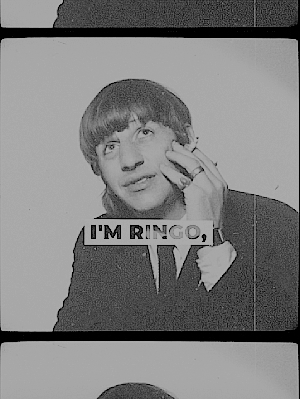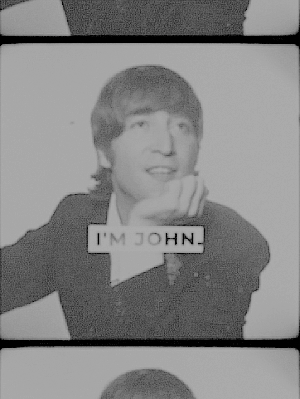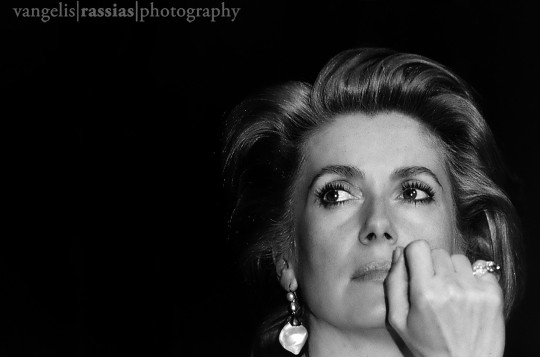#the greeting from live at the bbc from 1963
Text




Promo for ERAS: THE BEATLES on BBC SOUNDS. (x)
#i loved this promo so had to gif it!#the greeting from live at the bbc from 1963#and the pics by i think it's harry goodwin#feel free to correct me#oh and click on the x for the link to the video#:)#the beatles#john lennon#paul mccartney#george harrison#ringo starr#1960s#60s#my gifs#beatlesedit#thebeatlesedit
1K notes
·
View notes
Photo

#Catherine Deneuve Portrait
Cannes 1984
Contax RTS Carl Zeiss T* Tessar 200mm f/3,5 Agfapan 100
Catherine Fabienne Dorléac (born 22 October 1943), known professionally as Catherine Deneuve , is a French actress as well as an occasional singer, model and producer, considered one of the best European actresses and the greatest French actress of all time.. She gained recognition for her portrayal of icy, aloof and mysterious beauties for various directors, including Luis Buñuel, François Truffaut and Roman Polanski. In 1985, she succeeded Mireille Mathieu as the official face of Marianne, France's national symbol of liberty. A 14-time César Award nominee, she won for her performances in Truffaut's The Last Metro (1980), for which she also won the David di Donatello for Best Foreign Actress, and Régis Wargnier's Indochine (1992).
Deneuve made her film debut in 1957 and first came to prominence in Jacques Demy's 1964 musical The Umbrellas of Cherbourg. She went on to star in such films as Repulsion (1965), Donkey Skin (1970), Belle de Jour (1967), Tristana (1970) and The Young Girls of Rochefort (1967) opposite her sister, the actress Françoise Dorléac. She was nominated for the BAFTA Award for Best Actress for Belle de Jour, and the Academy Award for Best Actress for Indochine. She also won the 1998 Volpi Cup for Best Actress at the Venice Film Festival for Place Vendôme. Other notable English-language films include The April Fools (1969), Hustle (1975), The Hunger (1983) and Dancer in the Dark (2000).
Deneuve was born Catherine Fabienne Dorléac in Paris, the daughter of French stage actors Maurice Dorléac (1901–1979) and Renée Simonot (b. 1911). Deneuve has two sisters, Françoise Dorléac (1942–1967) and Sylvie Dorléac (born 14 December 1946), as well as a maternal half-sister, Danielle, whom their mother had out of wedlock in 1937 with Aimé Clariond, but who was later adopted by Maurice and took his surname. Deneuve was her mother's maiden name, which she chose for her stage name, in order to differentiate herself from her sisters. Deneuve attended Catholic schools .
Deneuve made her film debut with a small role in André Hunebelle's Les Collégiennes (1957) with her younger sister Sylvie Dorléac who, like their older half-sister Danielle, was an occasional child actress. She subsequently appeared in several films for director Roger Vadim as well as in L'Homme à femmes (1960), which caught the eye of Jacques Demy, who cast Deneuve in his 1964 musical Les Parapluies de Cherbourg, the film that brought her to stardom. Deneuve played the cold but erotic persona, for which she would be nicknamed the "ice maiden", in Roman Polanski's horror classic Repulsion (1965), reinforcing it in Luis Buñuel's Belle de Jour (1967), and reaching a peak in Tristana (1970).Her work for Buñuel would be her most famous .
Further prominent films from this early time in her career included Jean-Paul Rappeneau's A Matter of Resistance (1966), Demy's musical Les Demoiselles de Rochefort (1967) and François Truffaut's romantic thriller Mississippi Mermaid (1969). Deneuve remained active in European films during the 1960s and 1970s, though she limited her appearances in American films of the period to The April Fools (1969), a romantic comedy with Jack Lemmon, and Hustle (1975), a crime drama with Burt Reynolds. Her starring roles at the time were featured in such films as A Slightly Pregnant Man (1973) with Marcello Mastroianni and Le Sauvage (1975) with Yves Montand.
In the 1980s, Deneuve's films included François Truffaut's Le Dernier métro (1980), for which she won the César Award for Best Actress, and Tony Scott's The Hunger (1983) as a bisexual vampire, co-starring with David Bowie and Susan Sarandon, a role which brought her a significant lesbian and cult following, mostly among the gothic subculture. She made her debut film as a producer in 1988, Drôle d'endroit pour une rencontre, alongside frequent co-star Gerard Depardieu.
In the early 1990s, Deneuve's more significant roles included 1992's Indochine opposite Vincent Perez, for which she was nominated for an Academy Award for Best Actress and won a second César Award for Best Actress; and André Téchiné's two movies, Ma saison préférée (1993) and Les Voleurs (1996). In 1997, Deneuve was the protagonist in the music video for the song N'Oubliez Jamais sung by Joe Cocker. In 1998 she won acclaim and the Volpi Cup at the Venice Film Festival for her performance in Place Vendôme. In the late 1990s, Deneuve continued to appear in a large number of films such as 1999's five films Est-Ouest, Le temps retrouvé, Pola X, Belle maman, and Le Vent de la nuit.
In 2000, Deneuve's part in Lars von Trier's musical drama Dancer in the Dark alongside Icelandic singer Björk was subject to considerable critical scrutiny. The film was selected for the Palme d'Or at the Cannes Film Festival. She made another foray into Hollywood the following year, starring in The Musketeer (2001) for Peter Hyams. In 2002, she shared the Silver Bear Award for Best Ensemble Cast at the Berlin International Film Festival for her performance in 8 Women. In 2005, Deneuve published her diary A l'ombre de moi-meme ("In My Own Shadow", published in English as Close Up and Personal: The Private Diaries of Catherine Deneuve); in it she writes about her experiences shooting the films Indochine and Dancer in the Dark. She also provided the voice role of Marjane Satrapi's mother in Satrapi's animated autobiographical film Persepolis (2007), based on the graphic novel of the same name. In 2008, she appeared in her 100th film, Un conte de Noël.
Deneuve's recent work includes Potiche (2010) with frequent co-star Depardieu, Beloved (2011), alongside former co-stars Ludivine Sagnier and Chiara Mastroianni, the popular French adventure comedy Asterix and Obelix: God Save Britannia (2012) with Gerard Depardieu and Valérie Lemercier, screenwriter and director Emmanuelle Bercot's On My Way (2013), Palme D'or winning writer/director Pierre Salvadori's comedy drama In the Courtyard (2014), and André Téchiné's drama In the Name of My Daughter (2014). In 2017, she co-starred alongside Catherine Frot, in writer/director Martin Provost's French drama The Midwife, which has been acquired by Music Box Films for a summer 2017 distribution in the United States.
Deneuve appeared nude in two Playboy pictorials in 1963 and 1965. Her image was used to represent Marianne, the national symbol of France, from 1985 to 1989.[citation needed] As the face of Chanel No. 5 in the late 1970s, she caused sales of the perfume to soar in the United States – so much so that the American press, captivated by her charm, nominated her as the world's most elegant woman. In 1983, American Home Products retained her to represent their cosmetics line and hired world-renowned photographer Richard Avedon to promote its line of Youth Garde cosmetics, for which she famously proclaimed, "Look closely. Next year I will be 40."
She is considered the muse of designer Yves Saint Laurent; he dressed her in the films, Belle de Jour, La Chamade, La sirène du Mississipi, Un flic, Liza and The Hunger. In 1992, she became a model for his skincare line. In 2001, she was chosen as the new face of L'Oréal Paris. In 2006, Deneuve became the third inspiration for the M•A•C Beauty Icon series and collaborated on the colour collection that became available at M•A•C locations worldwide in February that year. Deneuve began appearing in the new Louis Vuitton luggage advertisements in 2007. Deneuve was listed as one of the fifty best-dressed over 50s by the Guardian in March 2013. In July 2017, Deneuve appeared in a video campaign for Louis Vuitton entitled Connected Journeys, celebrating the launch of the brand's Tambour Horizon smartwatch, which also featured celebrities, including Jennifer Connelly, Bae Doona, Jaden Smith and Miranda Kerr.
In 1986, Deneuve introduced her own perfume, Deneuve. She is also a designer of glasses, shoes, jewelry and greeting cards
Deneuve speaks fluent French, Italian and English and has some knowledge of Spanish, though she does not speak the language fluently. Her hobbies and passions include gardening, drawing, photography, reading, music, cinema, fashion, antiques and decoration.
Deneuve has been married once, to photographer David Bailey from 1965 to 1972. She has lived with director Roger Vadim, actor Marcello Mastroianni,cinematographer Hugh Johnson, Spanish model and current television presenter Carlos Lozano, and Canal+ tycoon Pierre Lescure.
Deneuve has two children: actor Christian Vadim, from her relationship with Roger Vadim, and actress Chiara Mastroianni, from her relationship with Marcello Mastroianni. She has five grandchildren.
Deneuve is close friends with the artist Nall and owns some of his works.
On 6 November 2019, BBC News reported that Deneuve suffered a mild stroke and was recuperating in a Paris hospital. Despite the health scare, there was no damage to her motor functions. Five weeks later, she was released from the hospital and spent the remainder of 2019 recuperating at her Paris home.
#catherine deneuve#portrait#portrait photography#famous actress#celebrity#black and white#beauty#french cinema#film star#movies star#beautiful#attractive#analog camera#film#cannes#film festival
15 notes
·
View notes
Text
Our ’Enry

WORDS BY LUKE G WILLIAMS
In an interview in 1977, the great Sir Henry Cooper remarked: “You only get out of life what you put into it. I earned my living as a boxer, but you can still conduct yourself in a gentlemanly way.”
These words serve as an apt introduction to a man whose fists may have wrought violence and destruction across 55 professional boxing contests, but whose geniality and warmth of personality endeared him to the nation.
Lambeth-born and Bellingham raised, Henry was that rare commodity – a boxer who was not only admired, but also genuinely loved. Across the 300 or more years that the sport of boxing has held a significant position within the collective British imagination, arguably no pugilist has been as widely and intensely loved as “our ’Enry”.
When he died on May 1, 2011 the country was deprived of one of its great post-war heroes – a man for whom the respected television commentator John Rawling coined the perfect epitaph: “He was a good boxer, but an outstanding man.”
The only boxer to ever be knighted – in recognition of his charitable work as much as his sporting prowess – Henry’s popularity traversed boundaries of class, age and gender.
To paraphrase Rudyard Kipling’s If, he was as comfortable displaying the “common touch”, pouring pints for punters at the Fellowship Inn in Bellingham, as he was “walking with kings” while dining at Buckingham Palace.
Henry was a staunch royalist – who had a portrait of the Queen Mother on his wall – and was at the same time suspicious of jingoism and avowedly opposed to racism in any form, as evidenced by his advocacy of the Anti- Nazi League, a group formed in 1977 to counter the rise of the far right.
Born in 1934, Henry and his identical twin brother George, as well as his older brother Bernard, were initially raised by parents Henry and Lily in Camberwell, but in 1939 they moved to a council house in Bellingham on Farmstead Road.
After brief spells in Sussex and Gloucestershire when they were evacuated – during which time their Bellingham home was hit by a German parachute mine – the Cooper brothers returned to south London in 1941.
Henry stayed on Farmstead Road with his parents until 1960, when he married his beloved Italian wife Albina. “It was a tight community,” he later said of his formative Bellingham years. “We all pulled together.”
Henry and George attended Athelney Road school and outside of school hours supported the family finances any way they could. Paper rounds, wood chopping and selling balls retrieved from the local golf course were among the innovative enterprises that put extra pennies in the collective kitty.
Henry and George’s entry into boxing came aged nine, courtesy of a neighbour who spotted their physical prowess and directed them to Bellingham Boxing Club.
Henry, naturally left-handed, nevertheless fought in the orthodox fashion and assembled an impressive amateur record for Eltham Boxing Club, winning 73 of 84 contests and competing at the 1952 Olympics.
Henry and George turned professional in 1954 under the management of the wily Jim Wicks. Although George would not ultimately match his brother’s fistic achievements, the two men were always extremely close.
“The only time we parted was when I got married,” Henry later recalled. “Even then, George came to live [with me] at Wembley until he was married.
“We went to school together, we went boxing together, we were together in the army. We look alike, we think alike, in temperament we’re similar and often we catch ourselves repeating each other’s remarks.”
Henry’s boxing career advanced quickly, and although he lost challenges for the Commonwealth, British and European titles in 1957, a famous victory against highly rated American Zora Folley the following year was the precursor to a points victory against British and Commonwealth champion Brian London at Earl’s Court in 1959.
Henry went on to successfully defend his British and Commonwealth titles on numerous occasions, earning a contest against one of the rising stars of world boxing in 1963 – a loudmouthed and undefeated 21-year-old American named Cassius Clay.
Rather than prepare for the fight in his usual environs of the Thomas A Becket pub on the Old Kent Road, Henry moved his training base to the Fellowship Inn in Bellingham, where the ballroom was converted into a makeshift gymnasium.
The influential American magazine Sports Illustrated reported: “For weeks he [Henry] lived at the Fellowship, taking his meals there, training in the back room when a wedding reception or tea party did not interfere.”
On an unforgettable night at Wembley Stadium, Henry’s preparations at the Fellowship almost paid off. His famed left hook smashed Clay to the canvas in the final seconds of round four – a moment that remains one of the most iconic in British boxing history.
For a few seconds a famous Cooper victory looked assured, but Clay recovered his footing – barely – and then in the interval before the following round his senses also returned, via a helping hand from some illegal smelling salts administered by his corner.
Henry was stopped while still on his feet in round five after suffering a terrible cut, with Clay labelling him “the toughest fighter I’ve ever met”. As for Henry, the magnanimous way he reacted to unfortunate defeat was typical of his generosity of spirit.
For the next few years he reigned supreme in Britain while Clay – who later renamed himself Muhammad Ali – went on to become champion of the world.
Ali granted Henry a rematch for the world title in 1966, in front of 46,000 fans at Arsenal’s Highbury stadium. Once again, Henry’s tendency to cut around the eyes proved his undoing as the referee stopped the fight in Ali’s favour in round six.
Henry subsequently added the European crown to his British and Commonwealth belts, before controversially losing all three titles in his final fight against Joe Bugner, a decision rendered by referee Harry Gibbs that was greeted with disbelief and catcalls by the fans.
In retirement, Henry, the first man to be twice named BBC Sports Personality of the Year, was much in demand as an after-dinner speaker, expert summariser and television personality – roles he fulfilled with distinction and integrity.
However, it was his more low profile – and unpaid – engagements at local boys’ clubs, sports clubs and boxing gyms that gave him the most pleasure.
When he died in 2011, a few days shy of his 77th birthday, old rival turned great friend Muhammad Ali was among those to pay tribute to a man whose prominence in British sporting folklore is assured.
“I am at a loss for words over the death of my friend, Henry Cooper,” Ali said. “Henry always had a smile for me; a warm and embracing smile. It was always a pleasure being in Henry’s company. I will miss my old friend. He was a great fighter and a gentleman.”
Above: Henry Cooper at the Fellowship Inn.
#lewisham#lewisham news#lewisham newspaper#london news#london newspaper#southeast london#catford#bellingham#deptford#blackheath#new cross#sydenham#telegraph hill#hither green#brockley#crofton park#forest hill#ladywell
0 notes